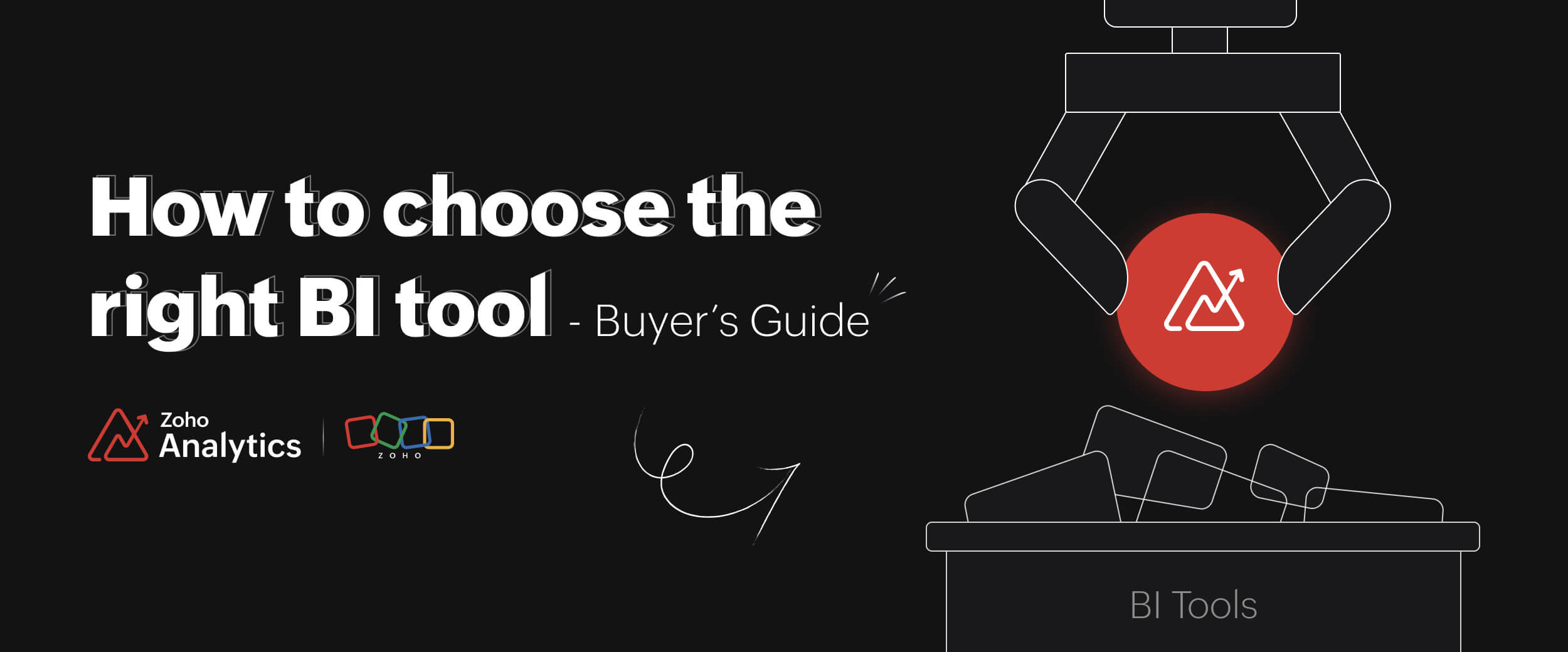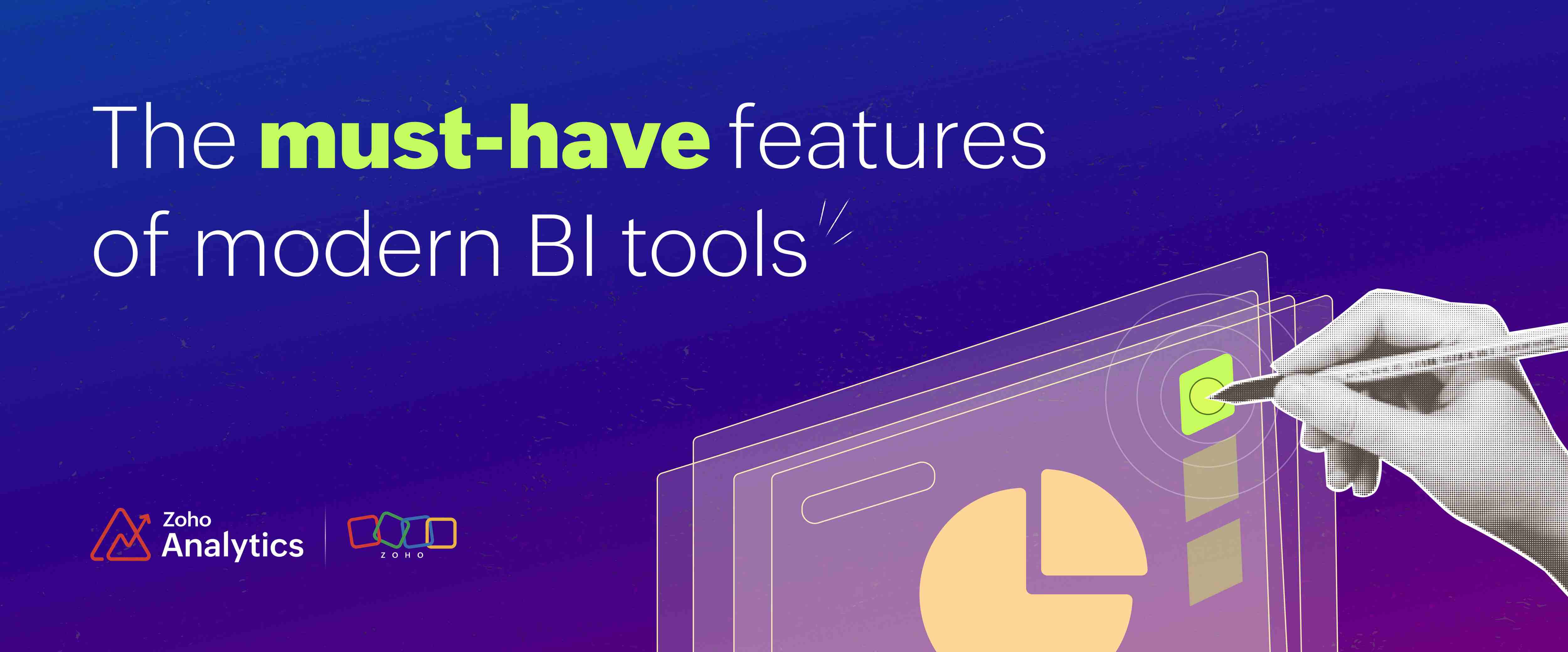- HOME
- BI & Analytics
- How to choose the right BI tool - Buyer's Guide
How to choose the right BI tool - Buyer's Guide
- Last Updated : April 21, 2025
- 165 Views
- 6 Min Read
Business Intelligence (BI) is the process of transforming raw data into actionable insights to drive smarter, data-driven decisions. It helps organizations analyze data, uncover trends, and optimize performance. While this is the simple and practical definition of BI, there are several definitions of business intelligence from different perspectives. Gartner defines BI as "an umbrella term that includes the applications, infrastructure, tools, and best practices that enable access to and analysis of information to improve and optimize decisions and performance." Similarly, Forrester describes BI as "a set of methodologies, processes, architectures, and technologies that transform raw data into meaningful and useful information." While BI may have different definitions, they all emphasize its core purpose—turning data into valuable insights for better decision-making.

What are BI tools used for?
BI tools are used to analyze, visualize, and interpret data to support decision making. By leveraging BI tools, businesses can stay on top of their performance by tracking key metrics in real time. Furthermore, BI tools enable companies to identify trends, patterns, and anomalies, helping businesses uncover new opportunities and risks.
In addition to data analysis, these tools make collaboration seamless by giving access to interactive reports and dashboards. Moreover, these tools enhance collaboration by providing access to interactive reports and dashboards, allowing teams to share insights effortlessly.
Beyond reporting and visualization, BI tools also leverage predictive analytics, enabling businesses to anticipate trends and plan with confidence. Finally, by analyzing customer feedback and behavior, BI tools help improve customer experience, making it easier to deliver meaningful interactions.
Who can use BI tools?
BI tools are for everyone who needs to analyze data, uncover insights, and make informed decisions, regardless of whether they're a part of a small business, a growing startup, or a large enterprise. These tools help different teams across industries streamline operations, improve performance, and drive better outcomes. Many teams, managers, and professionals use BI tools regularly, including:
- Business leaders and executives
- Sales and marketing teams
- Finance and accounting professionals
- Customer support and service teams
- Operation and supply chain managers
- HR and people analytics teams
- Data analyst and IT teams
- Small business owners and entrepreneurs
- Healthcare and educational professionals
How can BI tools help users?
By converting raw data into meaningful insights, BI tools empower users with better decision-making. They help businesses track key metrics in real time, uncover trends, and detect anomalies. Furthermore, these BI tools minimize manual effort while ensuring data accuracy by automating reports and analysis. Additionally, BI tools facilitate seamless collaboration with interactive dashboards and reports, making data easily accessible across teams. Businesses can forecast trends, refine strategies, and enhance customer experience through personalized, data-driven approaches using predictive analysis.
Improved decision making
- Convert raw data into meaningful insights.
- Get a clear view of sales, revenue, and customer trends with real-time dashboards.
- Anticipate trends and adjust inventory with predictive analysis.
Enhanced efficiency and productivity
- Automate reporting and data analysis, saving time on manual tasks.
- Improve team collaboration with interactive dashboards and shared reports.
- Reduce dependency on IT teams for data extraction and visualization.
Better customer insights and personalization
- Track customer behavior, preferences, and feedback.
- Enable customer segmentation and run targeted marketing campaigns.
- Help support teams improve response times and customer satisfaction.
Increased revenue and cost savings
- Identify high-performing sales channels and areas for revenue growth.
- Optimize pricing strategies by analyzing market trends and competition.
- Reduce unnecessary expenses by analyzing spending patterns.
Strong risk management and compliance
- Detect anomalies and security risks in finances.
- Comply with industry regulations.
- Identify potential risks in supply chain operations.
Competitive advantage
- Track market trends, competitor activities, and customer preferences.
- Provide insights into new business opportunities.
- Help businesses respond quickly to shifting market conditions.
Better workforce and resource management
- Help HR teams analyze employee performance, productivity, and retention.
- Assist in workforce planning by predicting future hiring needs.
- Improve efficiency by identifying operational bottlenecks.
Whether your goal is to enhance productivity, elevate customer satisfaction, cut expenses, or boost profits, BI tools offer the right solutions.
Why are BI tools important?
BI tools enable data-driven decision making by transforming raw data into actionable insights. Instead of relying on guesswork, companies can rely on BI tools to track key performance metrics, spot trends, and identify opportunities in real time. These tools streamline operations by automating data analysis and reporting, saving time and making collaboration easier across teams.
- Boost revenue and cut costs by optimizing pricing.
- Identify top-performing sales channels and track financial performance.
- Ensure regulatory compliance by detecting fraud.
- Keep business data secure.
- Provide insights into market trends.
In short, BI tools help businesses work smarter, not harder, making them an essential tool for success.
Tips to Choose the Right BI Tool for Your Business
The right BI tool should help your team make faster, smarter choices with data from day one. Here are a few practical tips to help you make the right decision:
Start with your business questions
Rather than asking, "What can this tool do?", ask, "What do I need to know to make better decisions?" Identify key questions each department wants answer to - like tracking sales trends, measuring customer satisfaction, or evaluating campaign effectiveness. Choose a BI tool that helps you uncover these questions quickly and clearly.
Match the tool to your team's comfort level
A powerful BI tool is useless if your team can't use it. Think about who will be working with the data - whether it's analysts, non-technical users, or a mix of both. Choose a platform that empowers users to explore data on their own without relying on IT constantly.
Try it out with your own data
Rather than watching a demo, get your hands on the tool and test it with your actual data. Focus on how easy it is to import data, create dashboards, and collaborate across teams. This is the best way to find out if the tool is truly intuitive or if it only looks good in a sales pitch.
See how fast you can go from data to answers
Time is everything when it comes to decision making. Can your team connect data, build reports, and answer questions without waiting long? The right BI tool should reduce the time between a question and answer.
Consider integration depth. Not just availability
Most of the BI tools say they integrate with popular apps, but what matters is how well they do it. Can the tool bring in data from all your critical systems like CRM, helpdesk, marketing, etc.? Choose a platform that has reliable integrations that work in the background, so you're not stuck uploading spreadsheets.
Think beyond dashboards
The goal isn't just to build dashboards - it's to make better decisions. Explore whether the tools support data story telling, alerts, or even predictive analytics. The more proactive the tool is, the more value it brings.
Know what you're really paying for
Pricing can be deceptive. Some tools look affordable at first, but the cost adds up fast for users, storage, advanced features, or even basic support can sneak in later. Understand the full pricing model: monthly pricing, setup time, and any hidden costs. A smart choice now saves you headaches (and money) down the road.
Make sure it helps teams work together
Sharing dashboards is one thing. But the real value comes when your team can comment on reports, tag each other, and have real conversations around the data - all in one place. Look for a BI tool that makes collaboration easy, so insights don't just sit in charts - they lead to action.
What are the best BI tools available in the market?
There are several BI tools available in the market, each offering different features based on data analytics, integration capabilities, data visualization, AI-powered analytics, and embedded analytics.
- Zoho Analytics
- Microsoft Power BI
- Tableau
- Looker
- Domo
- Sisense
A quick comparison of BI tools
Are you using the right BI tool?
To make the most of your data, finding the right BI tool is crucial. With so many options out there, how can you be sure you're using the right one?
Signs you might be using the wrong BI tool
Limited data integration: If your BI tool struggles to connect with data sources, applications, databases, or third-party tools, you're likely to miss out on valuable insights.
Complex setup and maintenance: If you're constantly relying on IT or data analysts to generate reports, your BI tool may not be the most user-friendly choice.
Lack of AI and automation: If your BI doesn't provide real-time insights, predictive analytics, or trend forecasting, you might be making decisions based on incomplete data.
Slow performance and scalability issues: If your reports take a lot of time to load or if your platform struggles with large datasets, it's holding your business back,
High costs without the features you need: If you're paying extra for basic features like data preparation, collaboration, or AI, your BI tool is overpriced and inefficient.
The right BI tool for your business: Zoho Analytics
Why let inefficient BI tools hold you back when you've got Zoho Analytics? With simplified data analysis and boosted productivity, it helps businesses of all sizes transform raw data into meaningful insights—all without breaking the bank.
Make the switch and sign up for a 15-day free trial or get a personalized demo today and see how Zoho Analytics stacks up against other BI tools!
Choose right. Choose Zoho Analytics.
 Vinisha
VinishaVinisha is a Marketing Analyst at Zoho Analytics with a strong passion for both marketing and data. She’s naturally curious about trends and loves diving into data to uncover what drives effective campaigns. She has a knack for simplifying complex information and presents insights in a relatable and engaging way that connects with audiences. Outside of work, she enjoys exploring the creative side of digital marketing.


